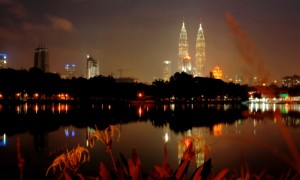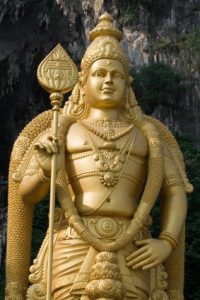I staggered to my hotel exhausted and ready to collapse. It was the longest flight I had ever taken (12 hours non-stop from London). The hotel staff gushed over me, noticing how exhausted I looked. Their sweet manner really made an impression, as you don’t encounter that sort of treatment everywhere.
I was informed by a local that the green belt around the city is there to reduce the temperature, particularly during the summer. The green belt is extremely beautiful and the current prime minister lives there. The trees also help reduce the cities level of pollution.
Exploring Kuala Lumpur the next day, I was struck by its beauty. In the Lake Gardens district there’s a monument to the communist insurgency. The memorial site took 5 years to construct. When Malaysia was a British colony, the British rode horses across the ravines, but today the Lake Gardens district very landscaped and includes a deer park, a butterfly park, and an orchid garden, which houses some of the world’s rarest orchids. There’s also the biggest bird park in the world- 3,000 birds, 200 species in 8 acres. As I walked, I noticed the red hibiscus flowers at every lamppost – hibiscus being Malaysia’s national flower.
The place where the hibiscus flowers were most evident was in Independence Square. It houses one of the world’s tallest free-standing flagpole. Not surprisingly – flags were everywhere. National identity seems to be taken very seriously in Malaysia.

Titiwangsa Park, in the north of Kuala Lumpur, is both a green and cultural area, because that’s where the National Theatre is. There’s also 5 art galleries in the north of the city – and it’s a place were families come to spend their weekends. In the park there’s horse riding, tennis and boat rides. For a second, you could forget you’re in a city, until you look up to the skyline of skyscrapers and super highways. Most dominant are the Petronas Twin towers, standing out over the whole skyline. These were once the tallest buildings in the world; an Argentine architect designed them. If you’re going to visit the towers, bring a book – the wait to get up there can last for hours.
Other interesting towers in the skyline include the Menara Telecommunications Tower, which is 5th tallest telecommunications tower in the world right now. It sits on Pineapple Hill, a forest reserve right in the heart of the city.
In the Golden Triangle, I recommend checking out the karaoke and the amazing designer stores – shopping complexes here are vast and beautiful. Designer clothes are often a third of the elsewhere. Of course there’s also the famous Chinatown, where you can find amazing bargains, right across from the Sri Mahamariamman temple, which is beyond beautiful. And be aware of the amazing trade in fake Cartier watches – it seems those things are everywhere!
The Malay cuisine is unlike anything I’ve ever eaten. Rice is eaten with various combinations of chicken, beef and fish, but there was one dish I noticed that was on every menu – Nasi Lemak, which my stomach simply couldn’t take. The mixture of everything from banana leaf to dried anchovies was too much.

For a most interesting day trip, I suggest checking out Batu Caves – a Hindy temple. But be warned taxi drivers will try and rip you off when you go there, so negotiate on the price before you step into the taxi. Once I arrived, I saw the world’s tallest statue of Murugan – a Hindu deity – in bright gold. The biggest cave is referred to as Temple Cave, and features ornate Hindu shrines. To reach it, visitors have to climb a steep 272 steps.
Batu Caves is the biggest Hindu shrine outside of India. At the entrance to the caves, there are stalls selling everything but guidebooks, so do bring one in advance. You can find a lot of books on spirituality, however, as well as various sweets, mango juice, and so on.
Approaching the steps to walk up to the caves, the hot sun beat down up us all. Cleverer tourists came prepared with umbrellas – in bright colors like orange, pink or purple. Some came up barefoot, as a sacrifice. Pilgrims were covered in flowers and/or carried coconuts to give to the gods. At the top, we encountered a tree that somehow managed to grow in the rock, surrounded by chickens. I also spotted a few white doves flying around – symbolic, perhaps?
At the top sat various women in colorful saris matching their umbrellas. I also saw hair locks on the ground – a guide explained that women sometimes cut off their long hair and offer it to the gods. He then added that previously, these locks were sometimes sold to Europeans to make wig.
We saw a religious ceremony taking place, a mass flowers were being offered to gods during this a man whose body was covered in white stripes (a guide explained: the three stripes, made with sacred ash, represent the three bonds of the soul – which are destroyed by God’s grace). He played an oboe and drums, and incense was burnt while the congregation recited prayers, standing barefoot, amongst banana skins and water dripping from cave.
It was beautiful – both chaotic and still at the same time.
